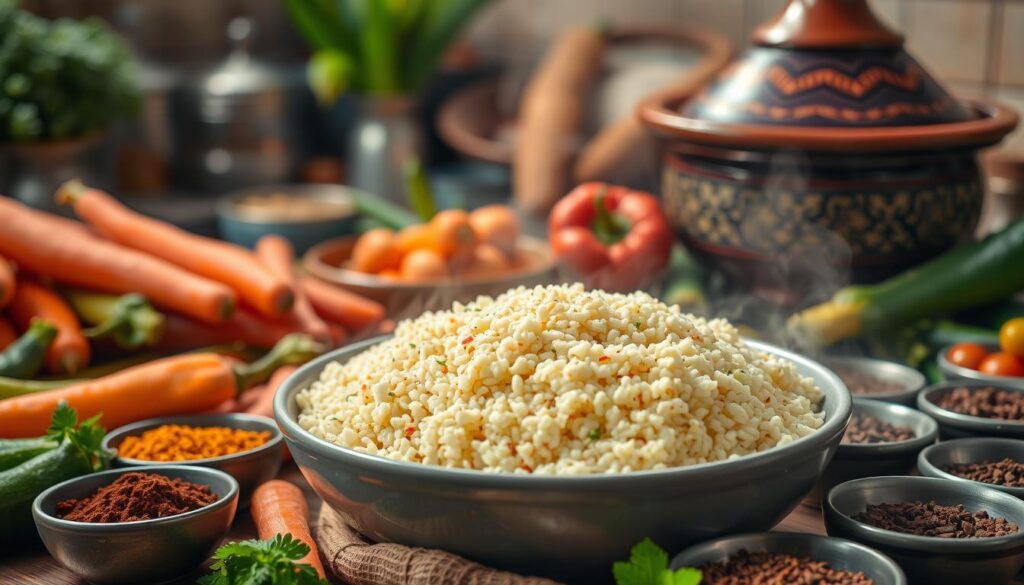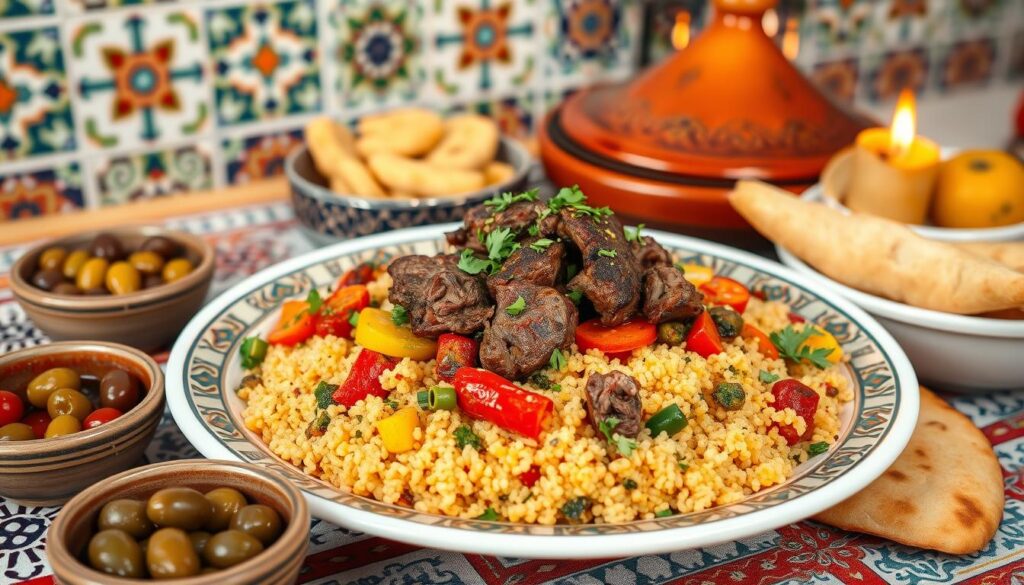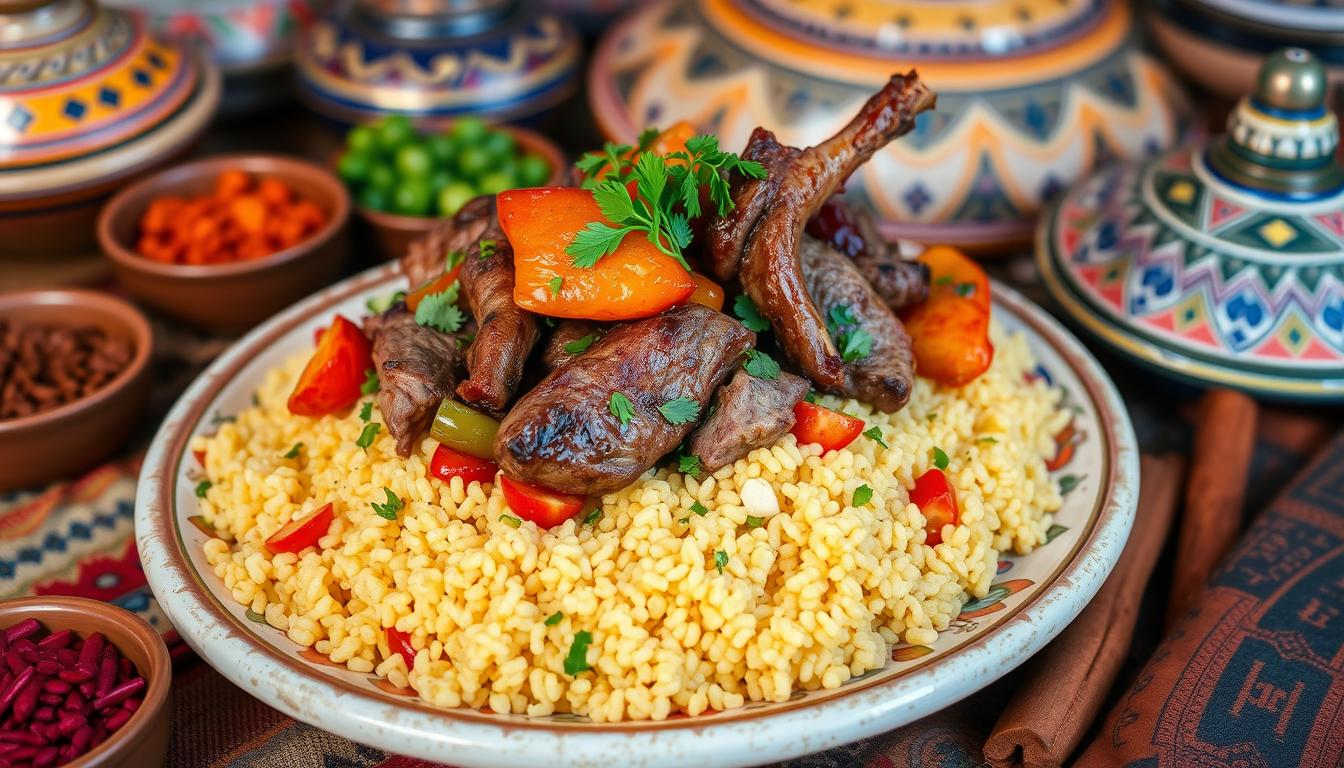The smell of spices and tender veggies takes me back to Marrakesh’s markets. My grandmother made her famous Moroccan couscous every Friday. It was a time for our family to come together. Now, I’m excited to share this recipe with you, so you can enjoy North African flavors at home – moroccan couscous recipe.
This Moroccan couscous is a tasty side dish that goes well with many proteins or as a veggie meal. The semolina grains are fluffy and pair well with colorful veggies, spices, and a hint of harissa. It’s a comforting dish that brings Morocco’s flavors to your table.
Introduction to Moroccan Couscous
Couscous is more than a dish in Moroccan cuisine; it’s a cultural tradition. This tiny semolina grain is steamed to fluffy perfection. It’s often at the center of Friday family gatherings.
Here, Moroccan families come together to share a meal. They cherish their communal dining experiences.
Overview of Moroccan Cuisine
Moroccan cuisine is known for its vibrant flavors. It’s rooted in the country’s rich cultural heritage and geographic diversity. Moroccan dishes blend Mediterranean, Middle Eastern, and African culinary traditions.
They feature fragrant spices, succulent meats, and fresh produce. This mix creates a unique taste experience.
Significance of Couscous in Moroccan Culture
In Moroccan culture, couscous is very special. It’s especially important as a Friday meal tradition. Families gather around a large communal dish of couscous.
They ladle flavorful broth and vegetables over the fluffy grains. This ritual mealtime is for bonding, conversation, and sharing the beloved national dish. Preparing and enjoying couscous together shows Moroccan hospitality and the value of community.
What is Couscous?
Couscous is not a grain, but tiny pasta made from semolina flour. It’s steamed to give it a light, airy texture. This makes couscous different from regular pasta. It’s used in many dishes, especially in Moroccan and North African cooking.
Couscous as a Tiny Pasta
Semolina grains from durum wheat make up couscous. The semolina is moistened, shaped into small balls, steamed, and dried. This process creates couscous’s unique taste and texture.
Couscous comes in different sizes, from small pearl to larger Israeli or Middle Eastern types. The size affects cooking time and texture, making it versatile in recipes.
Couscous is also known for its health benefits. It’s rich in carbohydrates, protein, and dietary fiber. This makes it a nutritious and filling part of meals.
Moroccan Couscous Recipe: Ingredients
To make a real Moroccan couscous, you need some special ingredients. Start with spices like cumin, cinnamon, and paprika. These add the Moroccan flavor to your dish.
Next, add fresh veggies like onions, carrots, zucchini, and eggplant. They make your dish colorful and tasty.
For protein, pick lamb, chicken, or go for chickpeas for a veggie option. You’ll also need broth, raisins, toasted nuts, and herbs like parsley and cilantro. These add to the authentic taste of Moroccan couscous.
This recipe makes 10 servings and is ready in 30 minutes. It’s a hit, with a 5-star rating from 33 reviews.
Some key ingredients include 2 cups of dry pearl moroccan couscous and 2 cans of 15oz chickpeas. You’ll also need 3/4 cup of chopped fresh parsley and 1 diced red pepper.
Don’t forget 1 cup each of diced English cucumber, sliced almonds, and raisins. The dressing has 1/4 cup of olive oil and zest from 1 lemon. It also has juice from 2 lemons, 3 minced garlic cloves, and spices like cumin and salt.
Step-by-Step Instructions
Sautéing the Aromatics
Start by sautéing onions, garlic, and spices in olive oil. This step is key to the dish’s flavor. Cook until the onions are soft and smell great.
Cooking the Couscous
Then, add broth to the pan and boil it. After boiling, take the pan off the heat. Stir in the couscous and cover the pan.
Let it sit for 10 minutes. This lets the couscous soak up the flavors and become fluffy. Unlike rice or quinoa, couscous doesn’t need rinsing. Steaming it makes it light and airy.
Garnishing and Serving
Finally, add raisins, toasted almonds, and parsley. Fluff the couscous with a fork before serving. Moroccan couscous is often served in a big dish.
Extra broth is served on the side. This lets everyone pour it over their couscous and veggies. It makes the meal feel truly Moroccan.

Moroccan Couscous recipe
Get ready for a flavorful adventure with this authentic Moroccan couscous recipe. It’s a favorite in North African cuisine. It has a tender vegetable stew in a fragrant broth, served over fluffy couscous. The mix of spices, fresh ingredients, and textures is a treat for your taste buds.
To begin, gather these ingredients:
- 1 1/2 cups of couscous
- 2 cups of chicken or vegetable broth
- 4 tablespoons of extra virgin olive oil
- 1/4 teaspoon of salt
- 1/4 teaspoon of black pepper
- 1/2 cup of dried apricots
- 1 ounce of fresh mint
- 1 red bell pepper, diced
- 1/2 of a red onion, diced
- 1 cup of canned chickpeas
To make this authentic moroccan couscous recipe, start by sautéing the onions and bell pepper in olive oil. Then, add the chickpeas and apricots. Let the flavors mix. Next, add the broth and simmer gently.
While the stew cooks, prepare the couscous. Follow the package instructions. Usually, you add the couscous to the broth, cover, and wait 10-15 minutes for it to soak up the liquid.
To serve, place the stew over the couscous. Top with fresh mint leaves. The mix of tender veggies, sweet apricots, and herbs makes a delicious authentic moroccan couscous recipe.
Variations and Serving Suggestions
Moroccan couscous is a versatile dish that can be adapted to many diets. The traditional version often includes lamb or other meats. But, you can make it vegetarian by leaving out the meat and using vegetable broth.
For a gluten-free option, swap couscous with quinoa or another gluten-free grain. This makes the dish inclusive and delicious for everyone.
Vegetarian and Gluten-Free Options
To make a vegetarian couscous dish, use flavorful vegetables like roasted bell peppers, zucchini, carrots, and chickpeas. You can also use gluten-free couscous instead of the traditional semolina. This way, those with dietary restrictions can enjoy the dish’s flavors.
Serving Moroccan Couscous Traditionally
- Moroccan couscous is traditionally served in a large, communal dish, allowing for a communal dining experience.
- Guests gather around the table, scooping the couscous and vegetables onto their plates and pouring the flavorful extra broth over the top.
- This shared style of eating encourages conversation and connection, making the meal an integral part of the Moroccan couscous tradition.

Whether you choose a classic meat-based version, a vegetarian couscous dish, or a gluten-free couscous adaptation, this beloved North African staple is sure to delight your taste buds. It brings a touch of Moroccan culture to your dining experience.
Storing and Reheating Leftovers
Moroccan couscous is delicious fresh or as leftovers. To keep it tasty, you need to store and reheat it right.
First, let’s talk about food storage. You can keep leftover Moroccan couscous in the fridge for up to 5 days. Store the couscous and stew in separate airtight containers. This keeps the couscous from getting soggy.
To reheat the leftovers, warm the couscous and stew together in a saucepan. Add a bit of broth or water to keep it moist. This way, your couscous leftovers will taste as good as the first time.
Reheating couscous is easy and saves you money. With good food storage, you can enjoy this dish for many meals.
Proper storage and reheating are key for keeping your couscous leftovers safe and tasty. Follow these tips to enjoy your Moroccan couscous for days.
Read Also: Authentic Moroccan Tagine Recipe: Easy & Flavorful
Conclusion
This authentic Moroccan couscous recipe brings the rich flavors of North Africa into your kitchen. It’s filled with tender vegetables, fragrant spices, and fluffy couscous. It’s perfect as a side dish or a main vegetarian course.
The recipe uses chickpeas and cranberries instead of raisins, giving it a unique twist. You can serve it with salted buttermilk, orange/apple juice, yogurt, or sour cream. This lets you customize your meal and make it even more special.
By trying this recipe, you connect with Morocco’s rich culinary heritage. Couscous has ancient roots, dating back to the 11th century in Kabylie. It’s loved worldwide, blending tradition with modern tastes. Enjoy this recipe and discover the wonderful flavors and traditions of Moroccan couscous.

